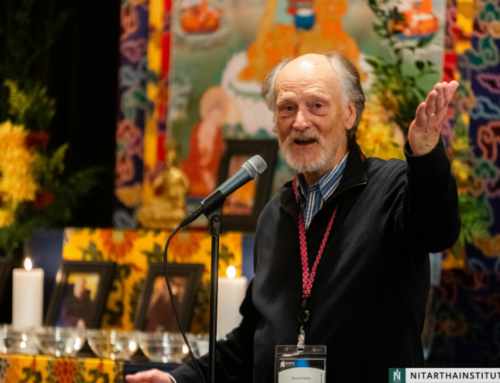This excerpt is copyrighted material, please do not use or copy without written permission from Nitartha Publications.
This is an excerpt from the sourcebook we use in our Mind & Its World II class. Mind & Its World II explores the criteria of valid cognition based on the teachings of the Pramāna tradition, or Buddhist epistemology. We will analyze our consciousness and determine to what degree it is in agreement with its observed object or not; what the difference is between non-mistaken, non-deceiving, conceptual and non-conceptual types of awareness. Practically speaking, this also provides the practitioner with the tools for delineating conceptual and nonconceptual types of mind in meditation.
MIND THAT APPREHENDS A PARTICULAR
Acharya Sherab Gyaltsen
We first need to look at what a “particular” is and, to use this language, it is the included object of something that includes. Let us look at an example. A “red car” is a particular instance, or an included object, of what includes. “Red car” is the included object of “car.” It is a particular instance of “car.”
The mind that apprehends this is a mind that apprehends a particular. Here the word “apprehends” is used in the context of apprehending a particular, and it is always that this is a conceptual mind.
Divisions Of Mind That Apprehends A Particular
As before, there are three divisions: a mind that apprehends a particular of a type generality,a mind that apprehends a particular of a collection generality, and a mind that apprehends a particular of a term generality.
A Particular Of A Type Generality
The generality “flower” includes many types of flowers, white flowers, red flowers, yellow flowers, and so on. “Flowers” pervades all types of flowers. It includes the many phenomena that belong to its type. What is the included object? It is a particular instance of flower, for example, a specifically characterized phenomenon that we call “flower.”
A particular of a type generality is not, necessarily, not a generality. If we use the example of a flower, a flower is both a particular of a type generality and a generality. It is both a particular and a generality. Flower is a generality in that, when we look at the definition of a generality, it is a phenomenon that includes many phenomena belonging to its own type. For example, if what includes the many phenomena belonging to its types is “things,” then “flower” is a particular instance of “things.” “Things” is the type generality and “flower” is a particular of the type generality “things.” From that point of view, it is a particular.
However, something that is a particular is not necessarily also a generality. If we take the example of these flowers in front, they are a particular of flowers because they have an includer or generality that applies to them. They are things; they are objects of comprehension; therefore they are considered to be a particular. But these flowers in front cannot be a generality because they are a specifically characterized phenomenon; they do not apply to the generality of flowers. A particular can be both a specifically characterized phenomenon, such as these flowers in front, and a generally characterized phenomenon, such as just saying “flowers.” When the particular is a generally characterized phenomenon, it can be both a particular and a generality. This was so in our first example of talking about flowers: how flowers could be both a particular of things and a generality applied to flowers. But when the particular is a specifically characterized phenomenon, such as these flowers in front, it can only be a particular. It cannot be a generality because a generality is always a generally characterized phenomenon.
A collection generality is a collection of many components. A type generality is not necessarily a collection generality because a type generality is not a collection of many components.
A Particular Of A Collection Generality
We use as our example the “woods at Gampo Abbey.” The “woods at Gampo Abbey” are a particular of a collection generality because they are an included object of something that includes a collection. They are a particular of “woods” in general. However, of course they can also be a generality, when you talk about the front edge of the woods at Gampo Abbey, the back part of the woods at Gampo Abbey. Then the front part of the woods at Gampo Abbey becomes that particular and the “woods at Gampo Abbey” become the collection generality.
To look at the difference between a particular of a type generality and a particular of a collection generality, we need to go back to the definitions of type generalities and collection generalities. A collection generality is a collection of many components. A type generality is not necessarily a collection generality because a type generality is not a collection of many components. It seems that type generalities and collection generalities have a musum relationship; but this is something you should analyze.
A Particular Of A Term Generality
The “means of expression” are words, phrases, sentences, and so forth. A particular of a term generality is a particular or an included object of something that includes many means of expression. For example, when you say “vase,” you are using a sound, or a means of expression. When you say, “vase,” a term generality arises to the conceptual mind. A particular of a term generality can be both a particular and a generality, as we have seen all along. When you say “vase,” from the view of the fact that a vase is a particular of “things,” it is a particular of a term generality. From the view of that it is what includes all vases, gold vases, copper vases, and so forth, it is a generality. Like our other examples, it can go both ways.
As with the other ones, a particular of a term generality can be both a specifically characterized phenomenon and a generally characterized phenomenon. When you say “vase,” that word or that sound is the specifically characterized phenomenon, or the way in which a particular of a term generality can be a specifically characterized phenomenon. On that basis of having said “vase,” a term generality arises to your conceptual mind, and it is described as being something similar, or having a similar aspect, to the word. It is a generally characterized phenomena. Anything that arises to the conceptual mind is a generally characterized phenomenon: therefore a term generality is a generally characterized phenomenon. That is an example of what a particular of a term generality is with respect to a vase. The object generality of a vase is—what arises to the conceptual mind—the aspect or part that is an imputation or superimposition, that is, it is simply the reverse of what is not vase.
To illustrate how term generalities and object generalities arise together, we will use an example of someone who knows the connection between terms and their reference. For such a person, when they apprehend a vase, both the term generality and the object generality arise to their conceptual mind. First they say “vase,” which is using the name, or using a means of expression. Just saying “vase” is a specifically characterized phenomenon of a term generality. Then having said “vase,” an object generality arises to the mind, which is based on the specifically characterized phenomenon “vase.” So, right away, an object generality as well as a term generality arise to the conceptual mind.
For someone who does not know any words, phrases, or means of verbal expression—for example, someone who is deaf—object generalities will arise to their conceptual mind but term generalities will not arise. All the generally characterized phenomena that arise tho this person’s conceptual mind will be object generalities. They will not be term generalities because term generalities are dependent on means of expression.
The connection between generalities and particulars is all something that occurs within the framework of the conceptual mind. The conceptual mind joins the appearance —the object or specifically characterized phenomenon—with the related generality for that object, and connects them as one thing. But from the view of the specifically characterized phenomenon itself, there is no connection between the generality and particular.
Let’ stake “compounded” as an example of a generally characterized phenomenon. Being compounded is not something that exists from the side of the specifically characterized phenomenon. When we say “compounded,” we mix together an appearance and a label, and we take then to be one thing. In this way, we make connections between generalities and particulars.
But from the side of the specifically characterized phenomenon itself, if we examine it, we see that no connection can exist between generalities and particulars. Whatever is a specifically characterized phenomenon cannot be a generality, and whatever is a generality is a generally characterized phenomenon. Specifically characterized phenomena are impermanent and generally characterized phenomena are permanent, so there can be no possible connection between them. For example, when we say “car,” it is a generality; it includes its many objects, that is, red cars, white cars, and so on. But there is no connection with a specifically characterized phenomenon. In fact, when we say “car,” we have to conclude that “car” is not a car, because there is no connection between the generally characterized phenomenon “car” and the specifically characterized phenomenon that we think we are referring to. It is only from the point of the conceptual mind that these two have a connection. For compounded phenomena, when we say “thing,” what arises in our conceptual minds, is the opposite of everything that is not “thing,” and in this case, when we say “thing,” it is a generally characterized phenomenon. Whatever is an includer or a pervader—which means a generality—is a generally characterized phenomenon. In our own tradition, generally characterized phenomena are nonthings. This is the view of Sakya Pandita and the seventh Karmapa Chodrak Gymatso.





